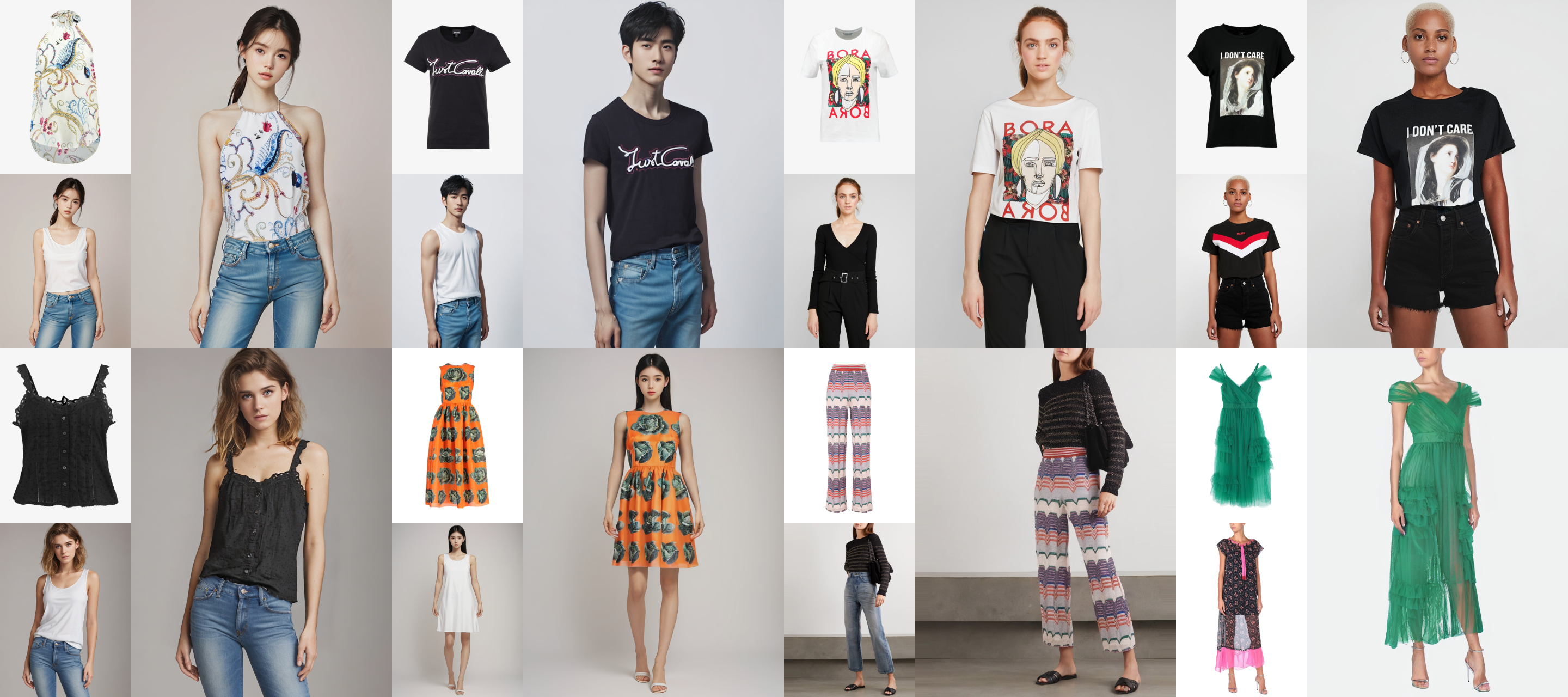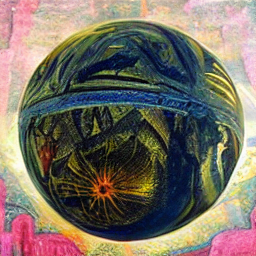ootdifussiondc
Maintainer: k-amir

4.9K

| Property | Value |
|---|---|
| Run this model | Run on Replicate |
| API spec | View on Replicate |
| Github link | View on Github |
| Paper link | No paper link provided |
Create account to get full access
Model overview
The ootdifussiondc model, created by maintainer k-amir, is a virtual dressing room model that allows users to try on clothing in a full-body setting. This model is similar to other virtual try-on models like oot_diffusion, which provide a dressing room experience, as well as stable-diffusion, a powerful text-to-image diffusion model.
Model inputs and outputs
The ootdifussiondc model takes in several key inputs, including an image of the user's model, an image of the garment to be tried on, and various parameters like the garment category, number of steps, and image scale. The model then outputs a new image showing the user wearing the garment.
Inputs
- vton_img: The image of the user's model
- garm_img: The image of the garment to be tried on
- category: The category of the garment (upperbody, lowerbody, or dress)
- n_steps: The number of steps for the diffusion process
- n_samples: The number of samples to generate
- image_scale: The scale factor for the output image
- seed: The seed for random number generation
Outputs
- Output: A new image showing the user wearing the selected garment
Capabilities
The ootdifussiondc model is capable of generating realistic-looking images of users wearing various garments, allowing for a virtual try-on experience. It can handle both half-body and full-body models, and supports different garment categories.
What can I use it for?
The ootdifussiondc model can be used to build virtual dressing room applications, allowing customers to try on clothes online before making a purchase. This can help reduce the number of returns and improve the overall shopping experience. Additionally, the model could be used in fashion design and styling applications, where users can experiment with different outfit combinations.
Things to try
Some interesting things to try with the ootdifussiondc model include experimenting with different garment categories, adjusting the number of steps and image scale, and generating multiple samples to explore variations. You could also try combining the model with other AI tools, such as GFPGAN for face restoration or k-diffusion for further image refinement.
This summary was produced with help from an AI and may contain inaccuracies - check out the links to read the original source documents!
Related Models

oot_diffusion

15
oot_diffusion is a virtual dressing room model created by viktorfa. It allows users to visualize how garments would look on a model. This can be useful for online clothing shopping or fashion design. Similar models include idm-vton, which provides virtual clothing try-on, and gfpgan, which restores old or AI-generated faces. Model inputs and outputs The oot_diffusion model takes several inputs to generate an image of a model wearing a specific garment. These include a seed value, the number of inference steps, an image of the model, an image of the garment, and a guidance scale. Inputs Seed**: An integer value used to initialize the random number generator. Steps**: The number of inference steps to perform, between 1 and 40. Model Image**: A clear picture of the model. Garment Image**: A clear picture of the upper body garment. Guidance Scale**: A value between 1 and 5 that controls the influence of the prompt on the generated image. Outputs An array of image URLs representing the generated outputs. Capabilities The oot_diffusion model can generate realistic images of a model wearing a specific garment. This can be useful for virtual clothing try-on, fashion design, and online shopping. What can I use it for? You can use oot_diffusion to visualize how clothing would look on a model, which can be helpful for online clothing shopping or fashion design. For example, you could use it to try on different outfits before making a purchase, or to experiment with different garment designs. Things to try With oot_diffusion, you can experiment with different input values to see how they affect the generated output. Try adjusting the seed, number of steps, or guidance scale to see how the resulting image changes. You could also try using different model and garment images to see how the model can adapt to different inputs.
Updated Invalid Date

k-diffusion

7
k-diffusion is an implementation of the diffusion model architecture described in the paper "Elucidating the Design Space of Diffusion-Based Generative Models" by Karras et al. It includes support for the patching method from the paper "Improving Diffusion Model Efficiency Through Patching". The model was created by nightmareai, who has also developed similar models like majesty-diffusion and real-esrgan. Model inputs and outputs The k-diffusion model takes a variety of inputs to control the image generation process, including a text prompt, an optional initial image, and various sampling parameters. The outputs are generated images. Inputs Text Prompt**: The text prompt to guide the image generation. Init Image**: An optional initial image to start the generation process. Init Scale**: Enhances the effect of the initial image. Sigma Start**: The starting noise level when using an initial image. Cutn**: The number of random crops per step. Churn**: The amount of noise to add during sampling. Cut Pow**: The cut power. N Steps**: The number of timesteps to use. Latent Scale**: The latent guidance scale, higher for stronger latent guidance. Clip Guidance Scale**: The CLIP guidance scale, higher for stronger CLIP guidance (0 to disable). Sampling Mode**: The sampling mode to use, such as DPM-2. Outputs Generated images Capabilities k-diffusion is capable of generating high-quality images from text prompts, with the ability to use an initial image as a starting point. It supports CLIP-guided sampling, which can help the generated images align more closely with the provided text prompt. The model also includes advanced sampling techniques like the DPM-2 sampler, which can produce higher quality samples with fewer function evaluations compared to the standard Karras algorithm. What can I use it for? You can use k-diffusion to generate unique, creative images from text prompts. This can be useful for a variety of applications, such as art creation, product visualization, and even content generation for marketing or entertainment purposes. The ability to use an initial image as a starting point can also be helpful for tasks like image editing or manipulation. Things to try Some things you could try with k-diffusion include experimenting with different text prompts to see the variety of images it can generate, adjusting the sampling parameters to find the settings that work best for your needs, and using an initial image to guide the generation process in interesting ways. You could also try combining k-diffusion with other models, like stable-diffusion, to create even more compelling and versatile image generation capabilities.
Updated Invalid Date

multidiffusion

2
MultiDiffusion is a unified framework that enables versatile and controllable image generation using a pre-trained text-to-image diffusion model, without any further training or fine-tuning. Developed by omerbt, this approach binds together multiple diffusion generation processes with a shared set of parameters or constraints, allowing for high-quality and diverse images that adhere to user-provided controls. Unlike recent text-to-image generation models like stable-diffusion which can struggle with user controllability, MultiDiffusion provides a versatile solution for tasks such as generating images with desired aspect ratios (e.g., panoramas) or incorporating spatial guiding signals. Model inputs and outputs MultiDiffusion takes in prompts, seeds, image dimensions, and other parameters to generate high-resolution images. The model outputs an array of generated images that match the user's specifications. Inputs Prompt**: The text prompt describing the desired image Seed**: A random seed value to control the image generation process Width/Height**: The desired dimensions of the output image Number of outputs**: The number of images to generate Guidance scale**: The scale for classifier-free guidance, controlling the trade-off between sample quality and sample diversity Negative prompt**: Text prompts to guide the image generation away from undesired content Outputs Array of images**: The generated images matching the user's input prompts and parameters Capabilities MultiDiffusion can generate high-quality, diverse images that adhere to user-provided controls, such as desired aspect ratio (e.g., panoramas) and spatial guiding signals. Unlike standard text-to-image models, MultiDiffusion does not require further training or fine-tuning to achieve this level of control and versatility. What can I use it for? The MultiDiffusion framework can be used for a variety of creative and practical applications, such as generating panoramic landscape images, incorporating semi-transparent effects (e.g., smoke, fire, snow) into scenes, and more. The model's ability to generate images based on spatial constraints makes it a powerful tool for tasks like product visualization, architectural design, and digital art. Things to try One interesting aspect of MultiDiffusion is its ability to generate images with desired aspect ratios, such as panoramas. This can be useful for creating visually striking landscape images or immersive virtual environments. Additionally, the model's spatial control capabilities allow for the incorporation of specific elements or effects into the generated images, opening up possibilities for creative and practical applications.
Updated Invalid Date

blur-faces

1
The blur-faces model is a simple AI model that applies a blur filter to input images. This model is similar to other image processing models like ifan-defocus-deblur, which removes defocus blur, and illusions, which can create various visual illusions. The model was created by kharioki. Model inputs and outputs The blur-faces model takes two inputs: an image and a blur radius value. The image is the input that will have a blur filter applied, and the blur radius determines the strength of the blur effect. The model outputs the modified image with the blur filter applied. Inputs Image**: The input image that will have a blur filter applied. Blur**: The radius of the blur filter to apply to the input image. Outputs Output**: The modified image with the blur filter applied. Capabilities The blur-faces model can apply a blur filter to an input image. This can be useful for tasks like obfuscating sensitive information in an image or creating a soft, dreamy effect. What can I use it for? The blur-faces model can be used for a variety of image processing tasks, such as: Blurring sensitive information in images before sharing them Creating a soft, blurred background in portrait photos Simulating a shallow depth of field effect in images Things to try You could try experimenting with different blur radii to achieve different levels of blurring in your images. Additionally, you could combine this model with other image processing models, such as masked-upscaler, to selectively blur only certain areas of an image.
Updated Invalid Date